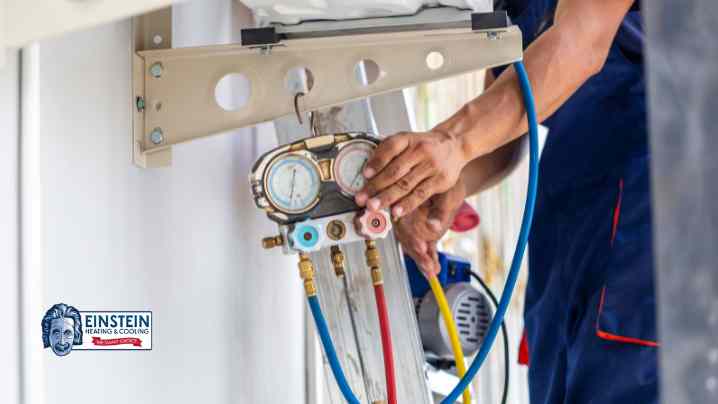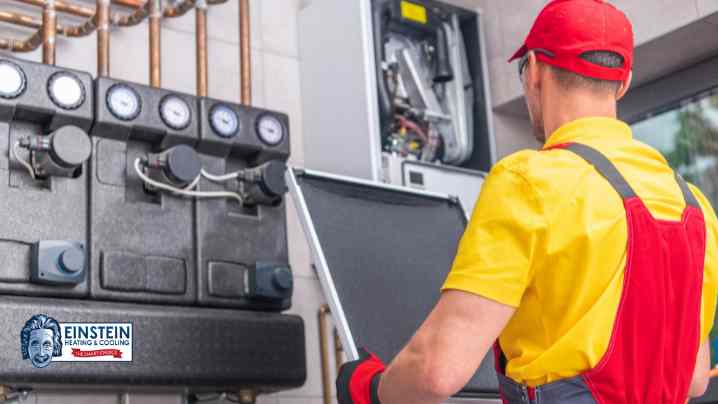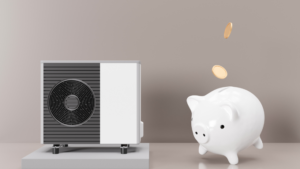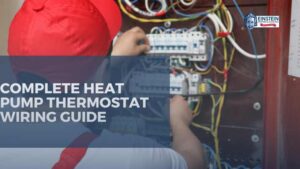When it comes to heating system installation, whether you’re upgrading your existing system or installing a brand new one, careful planning and the right materials are essential. A well-executed heating system installation can provide you with comfort and energy efficiency, while a poorly executed one can lead to a host of problems. In this article, we will discuss the key materials, tools, and instructions you need for a successful heating system installation in Bend, Oregon.
Assemble Materials for Heating System Installation
Heating Appliance
The heart of your heating system is the heating appliance, which varies based on the type of system you’ve selected. Here are the materials you need for each:
Furnace
For a forced-air heating system, such as a furnace, you’ll need the following materials:
- Furnace Unit: The furnace itself, which heats the air.
- Heat Exchanger: A vital component for transferring heat from combustion gas to the air.
- Burner: Responsible for igniting the fuel source.
- Blower Motor: To circulate heated air through the ducts.
- Combustion Chamber: Where the heating process takes place.
- Gas Line (if applicable): For natural gas or propane-powered furnaces.
Boiler
If you’ve opted for a boiler system, you’ll require the following materials:
- Boiler Unit: The central piece that heats water or steam.
- Pipes: To carry heated water or steam to radiators or other heating elements.
- Radiators or Baseboards: Devices to release heat into rooms.
- Expansion Tank: To accommodate the expansion of heated water.
- Pressure Relief Valve: Ensures safe pressure levels within the system.
- Gas Line or Oil Tank (if applicable): For fuel storage.
Heat Pump
For a heat pump system, materials include:
- Heat Pump Unit: The primary component for transferring heat.
- Refrigerant Lines: To transport refrigerant between the indoor and outdoor units.
- Air Handler: To distribute warm or cool air.
- Ductwork (if applicable): Required for forced-air systems.
- Electrical Wiring: To power the heat pump and its components.
Radiant Heating
Radiant heating systems rely on different materials, such as:
- Tubing: For hydronic systems, PEX or other tubing to carry heated water.
- Electric Heating Cables or Mats: For electric radiant heating.
- Thermal Insulation: To ensure that heat is directed upward and not lost downward.
- Control Panels and Sensors: For regulating temperature.
- Flooring Materials: Over which the heating elements are installed.
Ductwork or Piping
The distribution of heat in your home depends on the type of heating system. This section covers the materials you need for ductwork or piping.
Ductwork
If you have a forced-air heating system, ductwork is essential:
- Ducts: Rectangular or round sheet metal or flexible ducts.
- Duct Insulation: To prevent heat loss and maintain energy efficiency.
- Duct Connectors and Transitions: Ensuring a secure and airtight connection.
- Registers and Grilles: For airflow control and aesthetics.
Piping
For boilers and radiant heating systems, you’ll need various piping materials:
- Copper Tubing: Commonly used for hydronic systems.
- PEX Tubing: A flexible alternative for hydronic systems.
- Pipe Insulation: To prevent heat loss and protect against freezing.
- Manifolds: For even distribution of heated water.
- Valves and Fittings: To regulate flow and control direction.
- Pressure Relief Valves: Crucial for boiler systems.
Thermostat
A programmable thermostat is an integral part of your heating system. Ensure you have the right materials for its installation:
- Thermostat Unit: Digital or analog, depending on your preference.
- Mounting Hardware: Screws, anchors, or a wall plate.
- Wiring and Connectors: To link the thermostat to the heating system.
Ventilation and Air Filtration
Maintaining good air quality and ventilation is essential. These materials are key to achieving that goal:
- Air Filters: Disposable or washable filters to capture particles and maintain air quality.
- Air Purifiers (if desired): Additional devices for improving air quality.
- Ventilation Ducts and Fans (if applicable): For fresh air circulation.
Insulation and Sealing Materials
Proper insulation and sealing help maintain a comfortable indoor environment while saving energy:
- Insulation Materials: Such as fiberglass, cellulose, or foam boards for walls, floors, and attics.
- Caulk and Weatherstripping: To seal gaps around windows, doors, and other openings.
- Insulation Hangers and Supports: To secure insulation in place.
Electrical Wiring
For the safe and efficient operation of your heating system, ensure you have the necessary electrical components:
- Electrical Wiring: Appropriate wiring for connecting the heating system, thermostat, and electrical components.
- Circuit Breakers and Outlets: To provide power and control over electrical components.
Fuel Storage and Supply
If your heating system relies on a fuel source, consider these materials:
- Fuel Storage Tanks: Such as oil tanks or propane tanks, if necessary.
- Fuel Lines and Connectors: To transport fuel from the storage to the heating appliance.
Radiators, Baseboards, or Registers
For boiler systems, you’ll need materials to distribute heat in individual rooms:
- Radiators or Baseboards: Installed in rooms to release heat.
- Registers and Grilles: Covering duct openings for forced-air systems.
Expansion Tanks and Pressure Relief Valves
These components are essential for boiler systems to maintain safe pressure levels:
- Expansion Tanks: Allow for the expansion of heated water without causing system damage.
- Pressure Relief Valves: Safeguard against excessive pressure within the system.

Prepare Tools Needed
Installing a heating system is a complex task that demands specific tools and equipment to ensure a safe and efficient installation process. Having the right tools on hand is essential for achieving a successful heating system installation.
Basic Hand Tools
- Screwdrivers: Flat-head and Phillips screwdrivers are essential for various assembly and fastening tasks during installation.
- Adjustable Wrench: Used for tightening and loosening nuts and bolts.
- Pliers: Needle-nose and channel-lock pliers for gripping and manipulating small components.
- Pipe Wrench: For securely connecting and disconnecting pipes in hydronic heating systems.
Measuring and Layout Tools
- Tape Measure: To ensure precise measurements for proper equipment placement.
- Level: Essential for ensuring that the heating appliance and associated components are installed evenly and on a level surface.
- Combustion Gas Analyzer (if applicable): For testing and analyzing the combustion efficiency of certain heating systems like furnaces and boilers.
Cutting and Soldering Tools (for piping systems)
- Pipe Cutter: Used to cut pipes cleanly and precisely.
- Torch and Soldering Kit: For soldering copper pipes, a crucial step in hydronic heating system installation.
- Flux and Solder: Necessary materials for soldering joints securely.
Electrical Tools
- Voltage Tester: To ensure electrical circuits are properly disconnected during installation.
- Wire Strippers and Crimping Tool: For working with electrical wires and connectors.
- Circuit Tester: To verify electrical connections and troubleshoot issues.
- Electric Drill and Bits: Useful for drilling holes for mounting hardware, if required.
Insulation and Sealing Tools
- Caulking Gun: Used for applying caulk and sealants to fill gaps and seal joints.
- Utility Knife: For cutting insulation materials and other installation-related tasks.
- Insulation Hangers and Supports: To secure insulation in place.
Ventilation and Air Filtration Tools
- Duct Sealing Materials: Such as mastic or foil tape for sealing ductwork.
- Duct Insulation Wrap: For insulating exposed ducts to prevent heat loss.
- Air Flow Meter (if applicable): For measuring and balancing airflows in ducts.
Fastening and Mounting Tools
- Screws and Anchors: Necessary for mounting the heating appliance securely.
- Pipe Strapping and Hangers: To support and secure pipes.
- Mounting Hardware: Brackets or mounting plates for affixing the heating appliance to the floor or wall.
Safety Equipment
- Safety Glasses: Protect your eyes from dust, debris, and potential hazards.
- Gloves: To shield your hands and provide a firm grip on tools and materials.
- Respirator Mask: If working with insulation or sealants, a mask can protect you from inhaling harmful particles.
- Hard Hat (if required): In cases where there is a risk of falling objects or head injury.
Miscellaneous Tools
- Hole Saw: Useful for creating openings in walls or floors for ducts or piping.
- Pipe Threader (if required): For threading and connecting pipes in certain hydronic systems.
- Multimeter: To measure voltage, resistance, and continuity in electrical circuits.
- Pressure Gauge (for boiler systems): Essential for testing and adjusting the pressure within the system.
Diagnostic Tools (optional)
- Infrared Thermometer: For measuring temperature differentials in various parts of the heating system.
- Gas Leak Detector: For detecting and locating gas leaks in the system.
- Manometer (for certain systems): Used to measure gas pressure.
Having the appropriate tools readily available for your heating system installation is crucial to the efficiency and safety of the process.
Heating System Installation Process
The process of installing a heating system is a complex task that requires careful planning, attention to detail, and adherence to industry best practices. In this section, we will expand on the installation instructions for each type of heating system, including additional steps to ensure a successful installation.
Prepare the Space
Before you begin the actual installation of your heating system, it’s essential to prepare the space where the system will be placed:
- Clear the Area: Remove any obstacles or clutter from the designated space to provide a safe and accessible work environment.
- Ensure Cleanliness: Keep the installation area clean and free of dust and debris. This is especially crucial for systems like radiant heating, where cleanliness impacts efficiency.
- Verify Clearances: Check that there is adequate clearance around the heating appliance, allowing for proper ventilation and maintenance access.
Assemble the Heating Appliance
Properly assembling the heating appliance is a critical step, ensuring that it functions efficiently and safely. Follow these additional instructions for a successful assembly:
- Follow Manufacturer’s Instructions: Always refer to the manufacturer’s guidelines and the appliance’s user manual for precise assembly instructions.
- Secure Connections: Make sure all connections, such as gas or oil lines and electrical wiring, are secure and leak-free. This step is crucial for safety.
- Positioning: Position the heating appliance level and on a stable surface. Use appropriate mounting hardware if needed.
- Ventilation Considerations: For systems that require ventilation, such as furnaces or boilers, ensure that exhaust and intake pipes are correctly installed, with proper clearances and slope for condensate drainage.
Connect Ductwork or Piping
Connecting the ductwork or piping is essential for the proper distribution of heat. Here are some additional considerations for this step:
- Precision Installation: Ensure that all ducts or piping connections are airtight and well-insulated to prevent heat loss. Properly size and seal all joints.
- Balancing Ducts: For forced-air systems, consider installing dampers in ducts to balance airflow, ensuring even heating throughout the home.
- Insulate Exposed Ducts or Piping: In unconditioned spaces, such as attics or crawlspaces, ensure that exposed ducts or piping are adequately insulated to prevent heat loss or condensation.
Electrical Wiring
Proper electrical wiring is crucial for the safe and reliable operation of your heating system. Here are additional instructions for this step:
- Hire a Professional: If you are not experienced with electrical work, it’s best to hire a licensed electrician to ensure all connections are made safely and meet local electrical codes.
- Label Wiring: Ensure all wires are correctly labeled for easy identification in case of maintenance or future upgrades. Make sure to check for more maintenance tips.
- Check Voltage Compatibility: Verify that the electrical supply voltage matches the requirements of the heating appliance.
Thermostat Installation
Installing and setting up the thermostat is vital for controlling the temperature effectively. Additional steps include:
- Mounting Height: Install the thermostat at an appropriate height on an interior wall, away from direct sunlight, drafts, and heat sources.
- Program the Thermostat: Carefully program the thermostat to reflect your preferred temperature settings for different times of the day and week.
- Calibration: If necessary, calibrate the thermostat to ensure accurate temperature readings and system activation.
Ventilation and Air Filtration
For systems that require ventilation and air filtration, these instructions will help you maintain indoor air quality:
- Air Filter Installation: Ensure that air filters are correctly installed and positioned in the air handler or ductwork. Follow a regular maintenance schedule to replace or clean filters.
- Ventilation System Testing: After installation, test the ventilation system to ensure proper airflow and the removal of stale indoor air.
Insulation and Sealing
Proper insulation and sealing are crucial to maintain energy efficiency and prevent drafts. Here are additional instructions:
- Inspect Existing Insulation: Before adding insulation, inspect the existing insulation for damage or insufficient coverage. Replace or repair as needed.
- Caulking and Weatherstripping: Seal any gaps or cracks around windows, doors, and other openings to prevent heat loss and drafts.
- Insulate Attic and Crawlspaces: Pay special attention to insulating these areas to minimize heat loss.
Radiators, Baseboards, or Registers
For boiler systems, the installation of radiators, baseboards, or registers is a significant step:
- Balancing Valves: Adjust the balancing valves on radiators or baseboards to ensure even heating throughout the home.
- Proper Sizing: Make sure that the size and capacity of radiators or baseboards match the heating requirements of each room.
Expansion Tanks and Pressure Relief Valves
These components are essential for boiler systems to maintain safe pressure levels:
- Installation Precision: Follow manufacturer instructions for installing expansion tanks and pressure relief valves to prevent leaks or pressure issues.
- Testing: Test pressure relief valves to ensure they operate correctly and safely release excess pressure.
Test the System
Before considering the installation complete, a series of tests and checks are essential:
- Start-Up Testing: Activate the heating system and check for proper ignition, flame stability (if applicable), and the absence of any unusual noises.
- System Performance: Test the system’s overall performance by monitoring temperature rise, airflow, and heat distribution.
- Leak Testing: Inspect all connections and components for leaks, especially in the case of hydronic systems where water or steam is used.
Safety Checks
Before concluding the HVAC installation in Bend, thoroughly examine safety measures:
- Carbon Monoxide Detectors: Ensure that carbon monoxide detectors are correctly installed and functioning.
- Gas Leak Checks: For gas-powered systems, test for gas leaks by applying a gas leak detection solution to all gas connections and joints.
- Ventilation Inspection: Double-check that ventilation systems are properly installed and functioning, especially in systems that produce combustion gases.
Advantages of Heating System Installation by Experts
When it comes to heating system installation, enlisting the services of experienced and certified technicians from Einstein Heating and Cooling offers a range of significant advantages. While some homeowners may be tempted to undertake the installation as a DIY project, the complexity and intricacies of heating systems, as well as the potential risks involved, make expert installation a wise choice. Here are the key advantages of having heating systems installed by experts:
1. Expertise and Experience
Heating system installation experts bring a wealth of knowledge and experience to the table. They have a deep understanding of various heating system types, brands, and models, allowing them to select and install the most suitable system for your specific needs. Their experience also includes dealing with a wide range of installation challenges, ensuring a smooth and efficient process.
2. Proper Sizing and Capacity
One of the crucial factors in heating system installation is correctly sizing the system to meet your home’s heating demands. Professionals conduct thorough assessments of your property’s size, insulation, and other variables to determine the ideal capacity for your heating system. This ensures that your home remains comfortable while maximizing energy efficiency.
3. Safety Assurance
Safety is paramount in heating system installation. Professionals are well-versed in safety protocols and best practices. They can identify and address potential safety hazards, such as gas leaks or electrical issues, while ensuring that the heating appliance is properly vented and combustion gases are safely expelled. This minimizes the risk of accidents and exposure to harmful substances like carbon monoxide.
4. Compliance with Local Codes and Regulations
Heating system installations must comply with local building codes and regulations. Experts are familiar with these codes and stay up-to-date with any changes. By hiring professionals, you can be confident that your installation will meet all legal requirements and avoid costly fines or penalties associated with non-compliance.
5. Efficiency and Performance
Professional installers are well-versed in the intricacies of heating systems and can fine-tune the system for optimal efficiency and performance. They can balance airflow, set up zoning if needed, and ensure that all components are functioning at their best. This results in a heating system that operates smoothly and effectively, saving you money on energy bills in the long run.
Conclusion
A successful heating system installation requires careful planning, the right materials, and adherence to safety guidelines. Whether you’re upgrading your current system or installing a new one, following these instructions will ensure that you enjoy a warm and comfortable home throughout the year. Following our regular maintenance tips are essential for the longevity and efficiency of your heating system.
Heating system installation is a task best left to professionals due to the advantages they bring in terms of knowledge, safety, efficiency, and overall peace of mind. When you invest in expert installation from Einstein Heating and Cooling, you’re making a wise decision that will pay off in terms of comfort, cost savings, and long-term reliability. Stay warm and cozy with a well-installed and properly maintained heating system.








